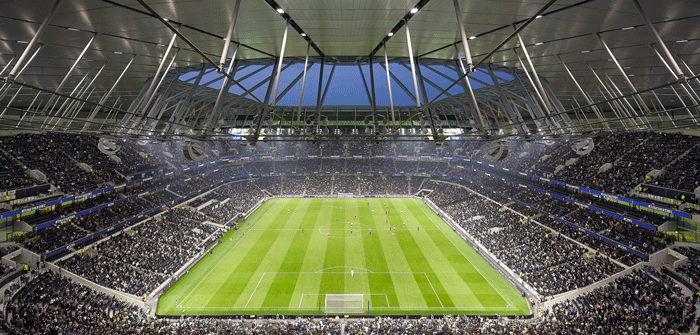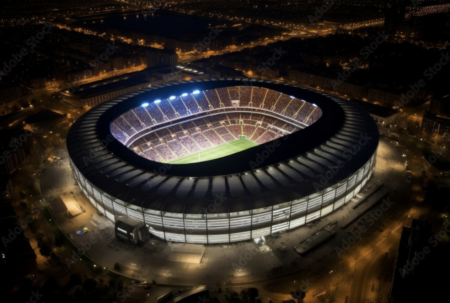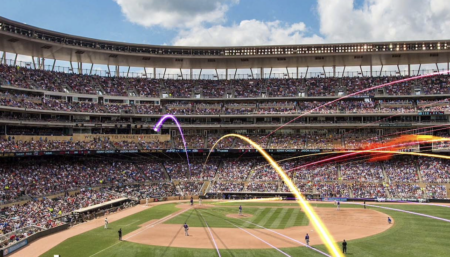Earlier this year it was confirmed that the new Tottenham Hotspur stadium will host its first night of boxing. Despite the COVID-19 outbreak delaying Anthony Joshua and Kubrat Pulev’s preparations, the first White Hart Lane bout since 1991 is undoubtedly still on its way. In this article, Buro Happold’s project lead Rob Amphlett discusses how the team behind the stadium designed it with this possibility in mind – creating a state-of-the-art venue for more than just soccer.
Just over a year ago Tottenham Hotspur opened a stadium designed to be the best in world soccer. A 62,000 all-seater ground which cost £1bn to build, its primary purpose was to give Spurs a modern home on its historic White Hart Lane site. But the new White Hart Lane though was created with more than just soccer in mind.
Clubs are under increasing pressure to keep revenue coming in on non-matchdays, particularly as it becomes easier for fans to watch elsewhere. For clubs operating in the modern game a stadium can prove to be a vital asset or a drain on resources. The difference is how it’s utilized after the final whistle blows. Designing a stadium is not just about creating a structure that houses a pitch any more, it’s about flexibility – and this was the brief given to us from the outset.
The new Spurs stadium has already been used by the NFL, starting an agreement with the league which will last until 2027. Prior to the COVID-19 outbreak, it had also booked rugby union and rugby league fixtures and outside sport, Guns N’Roses were due to play at the venue at the end of May.
One of the most recent high-profile announcements, though, is the news that the noble art is set to make its bow at the venue. Anthony Joshua’s highly anticipated world title defense against Kubrat Pulev is now delayed until the pandemic is curtailed. However, whenever it does go ahead it will bring tens of thousands of fans to White Hart Lane for the new stadium’s first foray into the world of boxing.
Boxing brings a new challenge to ensuring the fan experience at the venue – some fans will flood to ringside rather than taking seats in the stands, while the sole focus on the center of the stadium gives a different dynamic to the wider area used for team sports. Use for these different events was considered in the original design work, with every decision taken with the development of a versatile, multi-use arena in mind.
The versatility of the stadium is due in no small part to the ability to offer an enhanced fan experience, whatever the occasion. The technology the design facilitates is a key part of this – with the stadium built to house state of the art technology and enhanced connectivity. A lack of signal has long been an irritation of sports fans as they compete with thousands of others to get online, and the need for heightened connectivity was made clear to the project team from the outset. However, it also had to be achieved without compromising on the aesthetics of the design.
At Spurs, radio, mobile and Wi-Fi connectivity was integrated into the fabric of the stadium itself to ensure high performance, even at peak times. This was done through the development of an under-seat solution, with 1,600 wireless access points positioned throughout the stadium connecting via Wi-Fi antenna integrated into the seats themselves. This connectivity extends to the area around the stadium, allowing organizers to communicate practical information such as the length of queues, but can also be used to build anticipation before the event as fans approach.
Once the bell goes, the bout needs to be an immersive experience for fans from ringside to high up in the stands. The state-of-the-art AV system plays a large part in achieving this – four massive TV screens are installed (two of which are the largest screens in any European stadium), in addition to secondary screens carefully positioned around the arena to ensure every fan has clear sight of them. The hospitality areas high in the upper bowl are also designed to maximize views of the action – with the decision to use a lightweight cable net roof instead of more traditional but intrusive steel trusses allowing the development of a structure that appears to float above the seating below.
The second important element is the cauldron of noise created by the design of the stadium. The bowl shape and acoustic treatment to hard surfaces was deliberately designed and configured to boost the acoustics, with sound reverberating around the stadium rather than escaping, retaining noise and building to a crescendo. This was a vital part of the design process, with the vast, 17,500 seat South Stand acting as the engine room, and will ensure every fan from ringside upwards feels like they’re at the heart of the action.
For the millions watching at home, the broadcast facilities are second to none. Careful modelling was undertaken for camera positions, interview spaces and TV studios to ensure each is in the optimal position to capture every angle. This includes a spidercam system, operated via four half-ton winches and hidden from view to make it as unobtrusive as possible. This was a tricky design challenge, as we needed to find a way to house the winches and pulleys in the roof structure and navigate the logistics of getting the heavy winches into place.
The new White Hart Lane stadium will always be synonymous with Tottenham Hotspur. However, it delivers more than just a new home for the club. Facilitating the use of the latest technology was central to the stadium’s design, meaning it can shift seamlessly between events without sacrificing a shred of the atmosphere which Spurs fans will experience each week. Joshua v Pulev will show how this translates to boxing.
Despite its first being held in 1942, the old White Hart Lane only ever played host to four major bouts. Its successor is sure to eclipse this quickly, and it will start on the biggest stage of all – a heavyweight world title fight.





